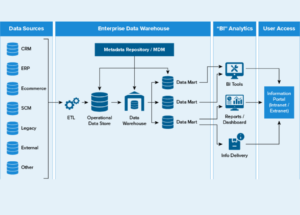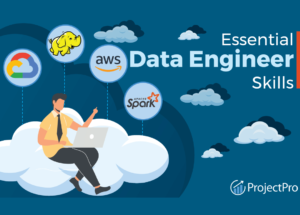
Big data is a term used to describe the large volume of data – both structured and unstructured – that inundates a business on a day-to-day basis. But it’s not the amount of data that’s important. It’s what organizations do with the data that matters. Big data can be analyzed for insights that lead to better decisions and strategic business moves.
One of the challenges of big data is the need for scalable data architecture. As the volume of data continues to grow, organizations require a data architecture that can scale to meet the increasing demands. A scalable data architecture is a blueprint for how data is processed, stored, and analyzed in a manner that can accommodate growth, as well as handle increasing levels of traffic and data complexity.
The objective of this article is to provide a comprehensive guide on how to build a scalable data architecture. We will cover the key components of scalable data architecture, and best practices for data processing and storage, and provide some real-world examples of how organizations are using scalable data architectures to drive their business.
Key Components of a Scalable Data Architecture
A scalable data architecture is made up of several key components, including data ingestion, data storage, data processing, and data visualization. Let’s take a closer look at each of these components.
Data Ingestion
Data ingestion refers to the process of acquiring data from various sources and loading it into a data storage system. The goal of data ingestion is to acquire data in a manner that is scalable, efficient, and reliable. The key to achieving this goal is to choose the right tools and technologies.
Apache Kafka is a popular open-source tool for data ingestion. Apache Kafka is a distributed, publish-subscribe messaging system that allows organizations to ingest data in real time. Apache Kafka is designed to handle large amounts of data and is capable of processing millions of events per second. It is also highly scalable and can be easily integrated with other big data tools, such as Apache Spark and Apache Flink, for data processing and analysis.
Data Storage
Data storage is the next component of a scalable data architecture. Data storage refers to the process of storing data in a manner that is scalable, efficient, and cost-effective. There are several options for data storage, including traditional relational databases, NoSQL databases, and cloud data warehouses.
NoSQL databases, such as MongoDB and Cassandra, are becoming increasingly popular for big data storage. NoSQL databases are designed to handle unstructured data, such as text and images, and are highly scalable and flexible. They are also able to handle high levels of write traffic, making them an ideal choice for big data storage.
Cloud data warehouses, such as Amazon Redshift and Google BigQuery, are another option for big data storage. Cloud data warehouses are designed to handle large amounts of data and are highly scalable. They are also cost-effective and can be easily integrated with other big data tools, such as Apache Spark and Apache Flink, for data processing and analysis.
Data Processing
Data processing is the next component of a scalable data architecture. Data processing refers to the process of transforming raw data into meaningful insights. The goal of data processing is to extract value from the data in a manner that is scalable, efficient, and reliable.
Apache Spark is a popular open-source tool for data processing. Apache Spark is a distributed data processing framework that allows organizations to process big data in real time. Apache Spark is designed to handle large amounts of data and is capable of processing millions of events per second. It is also highly scalable and can be easily integrated with other big data tools, such as Apache Kafka and Apache Flink, for data ingestion and storage.
Apache Flink is another popular open-source tool for data processing. Apache Flink is a distributed data processing framework that allows organizations to process big data in real time. Apache Flink is designed to handle large amounts of data and is capable of processing millions of events per second. It is also highly scalable and can be easily integrated with other big data tools, such as Apache Kafka and Apache Spark, for data ingestion and storage.
Data Visualization
Data visualization is the final component of a scalable data architecture. Data visualization refers to the process of presenting data in a visual format, such as charts and graphs, to allow for easier understanding and analysis. The goal of data visualization is to make data more accessible and understandable and to help organizations make better decisions.
Tableau is a popular data visualization tool. Tableau allows organizations to connect to a variety of data sources, including relational databases and cloud data warehouses, and create interactive visualizations. Tableau is designed to be highly scalable and capable of handling large amounts of data.
Best Practices for Building a Scalable Data Architecture
When building a scalable data architecture, there are several best practices to keep in mind. These best practices include:
Choosing the right tools and technologies: When building a scalable data architecture, it is important to choose the right tools and technologies. This includes selecting tools for data ingestion, storage, processing, and visualization that are scalable, efficient, and cost-effective.
Designing for scalability: When building a scalable data architecture, it is important to design for scalability from the outset. This means considering the growth potential of the data and the traffic patterns that will be required to handle that growth.
Implementing data security: When building a scalable data architecture, it is important to implement data security to protect sensitive data. This includes implementing security measures such as encryption, authentication, and access control.
Monitoring performance: When building a scalable data architecture, it is important to monitor performance and optimize as needed. This includes monitoring the performance of data ingestion, storage, processing, and visualization to ensure that the architecture is functioning optimally.
Real-World Examples of Scalable Data Architecture
There are several real-world examples of organizations that have successfully implemented scalable data architectures. These organizations include:
Netflix: Netflix has implemented a scalable data architecture to support its streaming service. The architecture includes Apache Cassandra for data storage, Apache Kafka for data ingestion, and Apache Spark for data processing.
Airbnb: Airbnb has implemented a scalable data architecture to support its online marketplace for rental properties. The architecture includes Apache Cassandra for data storage, Apache Kafka for data ingestion, and Apache Spark for data processing.
Uber: Uber has implemented a scalable data architecture to support its ride-hailing service. The architecture includes Apache Cassandra for data storage, Apache Kafka for data ingestion, and Apache Spark for data processing.
Conclusion
Big data is a growing challenge for organizations, and scalable data architecture is critical to ensuring that organizations can effectively manage and derive value from this data. A scalable data architecture is made up of several key components, including data ingestion, storage, processing, and visualization, and requires the right tools and technologies, a focus on scalability, and strong data security measures. By following best practices and utilizing real-world examples, organizations can build a scalable data architecture that meets the challenges of big data and drives their business forward.
Please join our Newsletter to be updated with our content and check our Blog for more articles like this.
Don’t forget to share it on social media channels with your friends!





